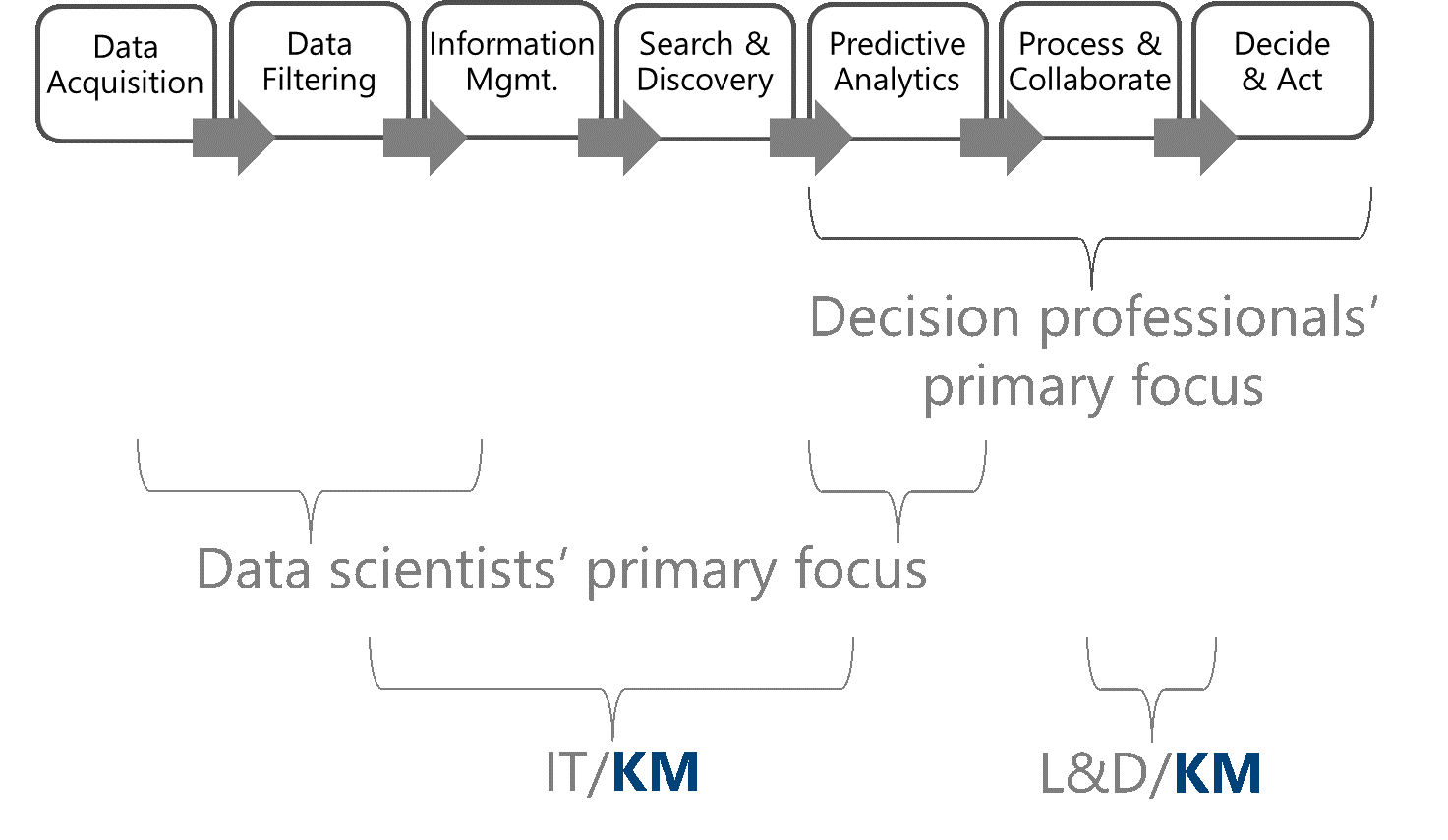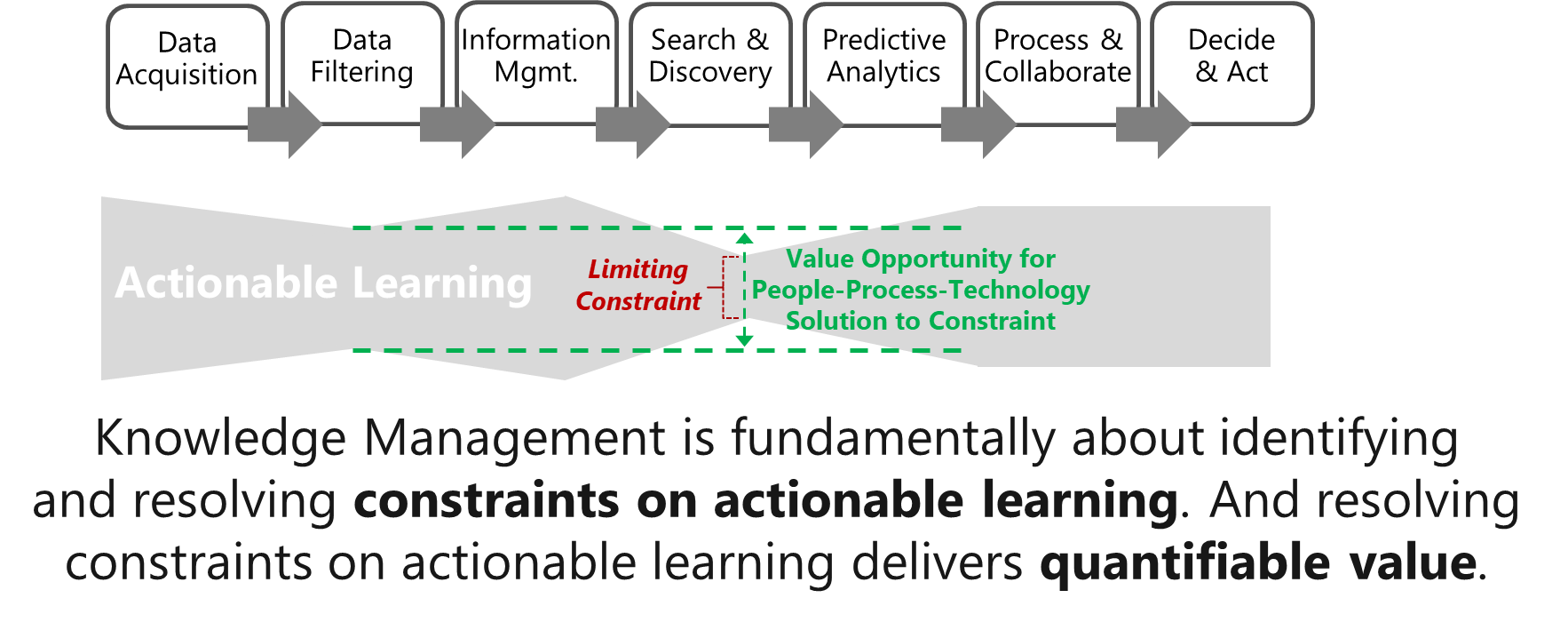I’ve discussed the fundamentals of knowledge in previous blogs. To recap the basics, knowledge is always the result of learning. Some kinds of learning cause a different decision to be made than otherwise would be made, and hence, a different action to occur. We call that kind of learning, actionable learning, and actionable learning results in actionable knowledge. Actionable learning, and the resulting actionable knowledge, have tangible value that can be quantified.
Now let’s put knowledge management, the functional area within an organization that is specifically focused on knowledge, in the context of the data-to-learning-to-action approach. We begin that exercise by acknowledging that our everyday use of the term, knowledge, is necessarily fuzzy in nature. For example, exactly where does data or information end and knowledge begin? And then there are those various shades of knowledge, such as “insights” and “wisdom.” Sometimes you see these various concepts stacked in pyramidal-style models with the positioning in the stack connoting relative value—but the boundaries between the sections of the pyramid nevertheless remain quite fuzzy. This type of fuzziness is not necessarily a bad thing by any means—many of our important concepts are necessarily fuzzy because attempting to make sharper distinctions may make sense for one context but may not for another.
But fuzziness can sometimes get in the way of getting things done and making tangible improvements. Mapping exactly what we mean when we are referring to “knowledge” or its variations to a data-to-learning-to-action (DLA) process can often help to provide the focus required to achieve tangible improvements. It can make the abstract more tangible because the mapping to a DLA process is a mapping to a physical process that has defined components that are organized in a specific, and universal, flow structure.

It is easy to see at a glance when mapped to a DLA process whether, when someone is referring to knowledge, they are talking about, for example, just filtered data or are they meaning, say, the output of a predictive model. These are obviously two very different positions within a DLA process and so the mapping makes the specific meaning clear to all. Every decision has a corresponding DLA process, so there always can be, and should be, an explicit mapping of the use of the words such as data, information, knowledge, expertise, insights, and wisdom, to a DLA process (and remember, DLA processes may be embodied in minds as well as machines, or in combinations thereof). That ensures a common understanding of what is meant, but also ensures that the words are aligned with what ultimately matters since it is the driver of long-term performance of our organizations—improving the effectiveness of our decisions.
The fuzziness of the concept of knowledge and its variations, of course, can also cause some fuzziness with respect to the knowledge management function, particularly regarding the specific areas of focus and responsibilities of the function. Again, this is not necessarily all bad—too sharp of delineations of responsibilities can sometimes lead to white spaces that lack ownership. On the other hand, fuzziness can cause some confusion and lead to grey spaces in which responsibility is shared but is not as fully embraced and/or coordinated as required for peak performance. I’ve found that, here again, putting knowledge management in the context of data-to-learning-to-action can be helpful by promoting greater clarity, serving to help eliminate white spaces, as well as enhancing the management of the grey spaces, thereby solving two different issues that can otherwise create a drag on performance.
Following is a data-to-learning-to-action diagram that I recently used to help decision analysts and data scientists, and their stakeholders, gain a better sense of each other’s primary areas of focus and facilitate more productive collaborations. But it also highlights other areas of the organization that necessarily have a role to play with respect to just about any data-to-learning-to-action process, including information technology, learning and development, and, of course, knowledge management.

Now, for any given organization, the specific focus areas of the roles may differ from what I have shown in this diagram. But generally, KM focuses on capabilities for managing information and knowledge and the ability to access it, as well as the more cognitive science/behavioral aspects of sharing expertise and collaborating effectively when making decisions. Of course, in some organizations the focus areas of the knowledge management function may be more extensive or narrower than that. But whatever the specific areas of focus and responsibility, they can be mapped to a DLA process, along with the areas of responsibilities of other functional areas, which can serve as a useful communications means to ensure that white spaces are eliminated and grey spaces are effectively managed.
And regardless of role, always the key to driving value for the organization is identifying and resolving constraints in DLA processes. That follows from the fundamental facts that, 1) decision effectiveness is the driver of the long-term performance of the organization, 2) decision effectiveness is driven by the effectiveness of the associated data-to-learning-to-action process, and, 3) the effectiveness of a data-to-learning-to-action process is necessarily governed by its limiting constraint on actionable learning.

A limiting constraint could, for example, be with respect to better access to information as shown in the diagram above, but, of course, it could reside at other places along the DLA process, such as the need for more effective collaborating in making the decision. Because of the KM function’s broad coverage with respect to many of an organization’s DLA processes, and importantly, because it focuses on both people and technology aspects within DLA processes, it is often ideally positioned to assist in identifying limiting constraints in DLA processes. This is a particularly important opportunity given that DLA processes invariably cut across organization boundaries and because, with the rapid rise of data science and the evolution of technologies such as machine learning, responsibilities are becoming increasingly fluid and blurred. So, this is an untapped and highly valuable leadership opportunity for KM functions that I hope will be seized!
In summary, data-to-learning-to-action can serve to help the knowledge management organization better manage responsibilities with other practices, better communicate with stakeholders, and quantify the value of their work and accomplishments. For that reason, I encourage knowledge management functions to take the lead in introducing their organizations to the data-to-learning-to-action approach and applying it in their day-to-day activities. It’s an opportunity to add even more value to your organizations because it can not only enable the KM function to do its own job more effectively, but enable KM professionals to facilitate maximizing the value-add of other functions as well.


Leave A Comment